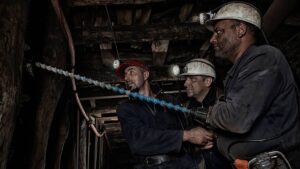ASX juniors are leading a clean energy revolution, chasing high demand critical minerals across the globe

Pic: Getty Images
At Adelaide’s recent Market Insights investor event, ResolveIR, Investability and Jane Morgan Management gathered together chiefs from nine explorers who are looking to add to critical minerals production as part of a global shift towards low-emissions technologies and its global supply chain.
Stockhead caught up with the presenters to hear details of the why, how and when these ASX juniors will push forward with their highly prospective projects.
American West Metals (ASX:AW1)
Dave O’Neill, MD
American West is laser-eyed at proving up its copper assets in northern Canada and Utah.
Storm has been a standout copper project since AW1 entered into an option agreement to acquire the project on Somerset Island, Nunavut, from TSXV-listed Aston Bay Holdings in March 2021, consistently publishing impressive copper drilling results.
The company will be soon shifting its focus to Utah, where AW1 is set to kick off the maiden drilling program at an earlier stage copper project called Copper Warrior.
Managing Director Dave O’Neill says there are compelling reasons for people to keep their eyes on base metals such as copper.
“The market optics suggest a rise in copper prices next year. Clearly there’s support from the clean metal transition, as all base metals including copper are used in batteries,” O’Neill says.
“A lot of countries are looking inward – especially the US – for their critical metal supply chains and we think we will be well set up to take advantage of that.”
Recently, American West expanded the footprint of near-surface mineralisation at the Storm project in Canada after drilling returned high-grade copper intercepts at the Lightning Ridge prospect and the 2200N Zone, intercepting highlight grades of 2.45% Cu from surface.
“We’re looking to finish off this year strongly with more drilling and more results from our current programs and next year we will build on our progress with more activity at Storm and other projects.”
Caspin Resources (ASX:CPN)
Greg Miles, MD
Spun out of Cassini when it was bought by OZ Minerals (now owned by BHP) for its West Musgrave nickel-copper project in 2020, Caspin owns the Mount Squires nickel-copper-gold-REE project in the same region.
Mount Squires includes a >40km structural corridor that has significant gold mineralisation and a 17km strike extension of the West Musgrave nickel and copper corridor where BHP is developing the $1.7bn Nebo-Babel copper-nickel deposit 10km away.
As exploration continued this year, the company accidentally made an REE discovery at the project’s Duchess copper-gold-molybdenum target. Results showed a whopping 46m @ 7,102ppm TREO, with more assays pending.
Caspin MD Greg Miles says Mount Squires is in a fantastic area.
“It’s grossly underexplored, with the potential for discoveries in many different commodities, but most of our focus is on the nickel and copper potential. And that’s what we’re really putting our effort into,” Miles says.
“At the same time, when you go out into the frontiers, you never know what you’re going to find and we’ve been excited by a new rare earth discovery.
“Now rare earths aren’t necessarily rare, but what’s different about our discovery is that it’s got a really high proportion of heavy rare earths, which are much more valuable.”
It also owns the Yarrawindah Brook PGE-Ni-Cu Project and more recently highlighted lithium potential where the regional potential for a discovery was highlighted by global lithium major Sociedad Química y Minera de Chile (SQM) and sits on the same geological terrane as the world’s largest lithium mine – Greenbushes.
Pursuit Minerals (ASX:PUR)
Aaron Revelle, MD
With a recently acquired lithium carbonate pilot plant and an imminent Stage 1 drilling program for its Rio Grande Sur brine-lithium project, Pursuit Minerals is aiming to become the next cab off the rank to produce battery-grade lithium carbonate in Argentina’s Salta province.
Lithium from brines comes from ‘salars’, or salt flats, and miners implement extraction techniques similar to those utilised in the oil and gas sector.
The Rio Grande Salar – home to extensive historical exploration – has an inferred resource of 2.1Mt lithium carbonate equivalent (LCE) grading @ 370mg/l to a depth of 100m and is considered open at depth.
Pursuit believes those figures provide lots of potential for building out a resource while already offering a clear pathway to production at, according to the US Geological Survey, the home of the largest pipeline of significant new lithium mines in the world.
MD Aaron Revelle says the pilot plant will be the company’s first production of LCE, which will be assessed before moving the plant up to the site at Rio Grande Sur.
“The project sits within the existing NI-43-101 resource to which Pursuit has recently completed its own geophysics surveys, which will have identified the drilling locations for our upcoming drilling program,” Revelle says.
“Over the coming months, investors can expect us to commence our maiden drilling program, which is expected to culminate in our maiden resource,” Revelle says.
Future Metals (ASX:FME)
Jardee Kininmonth, CEO/MD
Focused on copper, nickel and platinum group metals (PGM), Future Metals owns the Panton project in the East Kimberley containing a resource of 6.9Moz @ 3.57g/t palladium equivalent.
FME also recently entered into an option agreement to acquire Osprey Minerals, which owns ~100km2 of highly prospective exploration tenements including the Eileen Bore deposit, within a 20km radius of Panton.
PGM’s include the six high-value elements of platinum (Pt), palladium (Pd), rhodium (Rh), ruthenium (Ru), osmium (Os) and iridium (Ir) – valued in many industries for their high resistance to wear and tarnish characteristics.
“[Panton] is the highest-grade PGM project in Australia and one of the highest-grade undeveloped PGM projects in the world,” Kininmonth says.
“We also have a very high-grade 3.2Moz discreet (or coherent) high-grade reef as well, and when taking that forward, it allows us to look at a lower capex.
“It’s worth noting, again, that this PGM exposure is quite rare, particularly outside of South Africa and Russia, which are the two predominant supply hubs for PGMs, and clearly not the most sought-after investment jurisdictions, particularly relative to WA.
“We are actually redoing our resource on the Panton project which I think will highlight its great advantage even further.
“We’re also working on its chromite content within that resource. And again, it’s one of the highest-grade chromite deposits in Australia”
TG Metals (ASX:TG6)
David Selfe, CEO
Hailing from mining major Glencore with experience in project assessments across the globe, nickel guru and TG6 CEO David Selfe’s top priority is the company’s nickel and lithium deposits in the Lake Johnston Greenstone belt in WA.
The geology of Lake Johnston has attracted a number of miners to the region recently due to its Archaean-aged geology over the years, yet underdeveloped compared to surrounding similar Greenstone belts that play host to very fertile gold, nickel and lithium terrane.
With more than $3m in the kitty on hand from its recent entry into the ASX, TG Metals is proving up targets for both commodities at its highly prospective tenure in the Tier-1 Goldfields mining district.
“Both nickel and lithium are essential in lithium-ion batteries, which are playing a major role in electric vehicles and also in energy storage, particularly for wind farms and solar farms,” Selfe says.
“We’ve got 50km of Greenstone belt under tenements and we’re just south of the Maggie Hayes and Emily Ann nickel deposits.
“We’ve completed our first phase of air core drilling on our nickel laterite at Lake Johnston and we’ve got some high-grade results from that up to 3% Ni, which is quite rare in laterite.
“And we’re currently doing our nickel surface drilling where we’re drilling this diamond drill core and RC drilling on our lithium prospects. What’s in the works? A lot – in the works and assays to come.”
Narryer Metals (ASX:NYM)
Richard Beven, Non-exec Chair
Narryer Metals is focused on critical minerals projects across lithium, nickel and rare earths in Canada and Australia.
“We recently acquired five projects in Ontario and Quebec. It’s a really hot piece of geology in the world at the moment,” non-exec chair Richard Beven says.
Pontax East, Le Moyne and Walrus Island are in the hot James Bay lithium district in Quebec, while in Ontario, Narryer is looking to prove up lithium deposits at the Eades and Hailstone tenements.
The geology of the tenure across the two Canadian provinces is lithium-rich, and Narryer’s aim is to become a key part of the global shift to cleaner energy, while at the same time earning returns for investors.
“We’ve acquired these early-stage projects, where very little work’s been done [and] we’ve got our CEO and managing director Gavin England on the ground at the moment engaging with the communities and doing a first pass on some exploration,” Beven says.
“For us, it’s the opportunity to take a really greenfield piece of geology and there’s plenty of upside.”
Back in WA, the explorer also has a rare earths target, the Rocky Gully project, which Beven says has very similar geology to WA1 Resources’ (ASX:WA1) West Arunta REE project and has plans to start drilling in Q1 2024.
Sparc Technologies (ASX:SPN)
Stephen Hunt, Exec Chair
As the name suggests, Sparc Technologies is a South Australian tech company focusing on improving performance costs and environmental outcomes, developing three key products for the resources sector.
“We’re developing an Ecosparc graphene additive product which we’re adding into coatings for anti-corrosion properties thereby reducing the cost to the user of the coating,” Sparc exec chair Stephen Hunt says.
Independent assessment shows steel assets coated with Ecosparc-enhanced coatings can reduce CO2 emissions by up to 21%, and maintenance costs of up to 23%, when benchmarked against the same non-graphene-enhanced epoxy protective coatings.
“We’re also working with green hydrogen technology,” Hunt says.
“Instead of having electrolysis with wind farms and solar farms producing electricity into the electrolysis, we’re doing away with all of that and using photocatalytic water splitting, so just using photocatalysis in a reactor to split the water. That’s very exciting technology.”
Real-world testing at CSIRO’s Energy Centre in NSW is underway to determine its viability.
“Thirdly, we are working in the sodium ion battery space, whereby we are looking to develop an anode for a sodium ion battery, which seems to be quite a game-changer in the battery world.”
ChemX (ASX:CMX)
Peter Lee, CEO
Essentially two high-purity companies in one, ChemX, led by CEO Peter Lee, is aiming to produce both high-purity manganese (HPM) and high-purity alumina (HPA), both key ingredients in Electric Vehicle (EV) batteries.
The HPM is sourced from the Eyre Peninsula and ChemX is currently proposing to locate a hydrometallurgical facility in Whyalla, SA only a short 150km from its 100% owned tenements, just south of Kimba, SA. The HPA on the other hand is sourced from industrial chemicals so is not tied to mine feedstock or location. Both HPM and HPA are targeting 99.99% (4N) purity.
At the Jamieson Tank deposit, a maiden resource of 13Mt @ 5.7% was recently announced, from which ChemX plans to produce it’s high-purity manganese sulphate. ChemX’s current plan is to double the tonnes and double the grade in Q1 2024, and a drill program is in the planning phase to achieve this.
ChemX also recently approved the construction of its HPA pilot plant based in WA for Q4 2023 and will commission in Q1 2024, whereupon in Q2 2024 it will produce the necessary material to meet specific customer qualification purposes.
The nominal pilot plant size is to be nominally 24tpa and the unique (patent pending) process holds noteworthy advantages over conventional Kaolin to HPA flowsheets including significantly lower CAPEX and OPEX costs.
“ChemX is in the business of building better batteries, though the creation of high-purity Australian products with exceptional ESG credentials” Lee said, adding that the company was keen to establish downstream high-value processes in South Australia and Western Australia.
Alligator Energy (ASX:AGE)
Greg Hall, CEO/MD
Operating for more than 10 years, Alligator Energy is a uranium exploration and development company focused on the 18.1Mlb @ 720ppm U3O8 and growing Samphire project in South Australia, where a scoping study has outlined a low-cost, low-impact start-up.
It recently raised $3.26m in an oversubscribed capital raise for exploration drilling and a feasibility study of Samphire. An updated resource is due in November, with feasibility studies pencilled in for 2024.
Encouraging progress is being made at the Nabarlek North project in the prolific Alligator Rivers uranium hotspot in the NT, with geophysical and geochemical surveys identifying 23 priority targets which are currently being assessed.
AGE is also advancing work on its Big Lake project in South Australia and Piedmont project in Italy.
“We are undertaking a number of key tasks across the coming months and years which will put us right in the steps of direction for future production out of the project,” AGE CEO Greg Hall says.
Hall says the uranium price is starting to reflect the supply and demand fundamentals that have been known in the market for a long time – now it’s coming to fruition.
“What we’re seeing now is cash is becoming more available for project exploration and development – we ourselves have raised over $25m, so the cash is there and available for projects that can genuinely be taken forward.”
This article was developed in collaboration with Adelaide Market Insights, a Stockhead advertiser at the time of publishing.
Sparc Technologies are Stockhead advertisers, they did not sponsor this article.
This article does not constitute financial product advice. You should consider obtaining independent advice before making any financial decisions.
Related Topics
UNLOCK INSIGHTS
Discover the untold stories of emerging ASX stocks.
Daily news and expert analysis, it's free to subscribe.
By proceeding, you confirm you understand that we handle personal information in accordance with our Privacy Policy.








